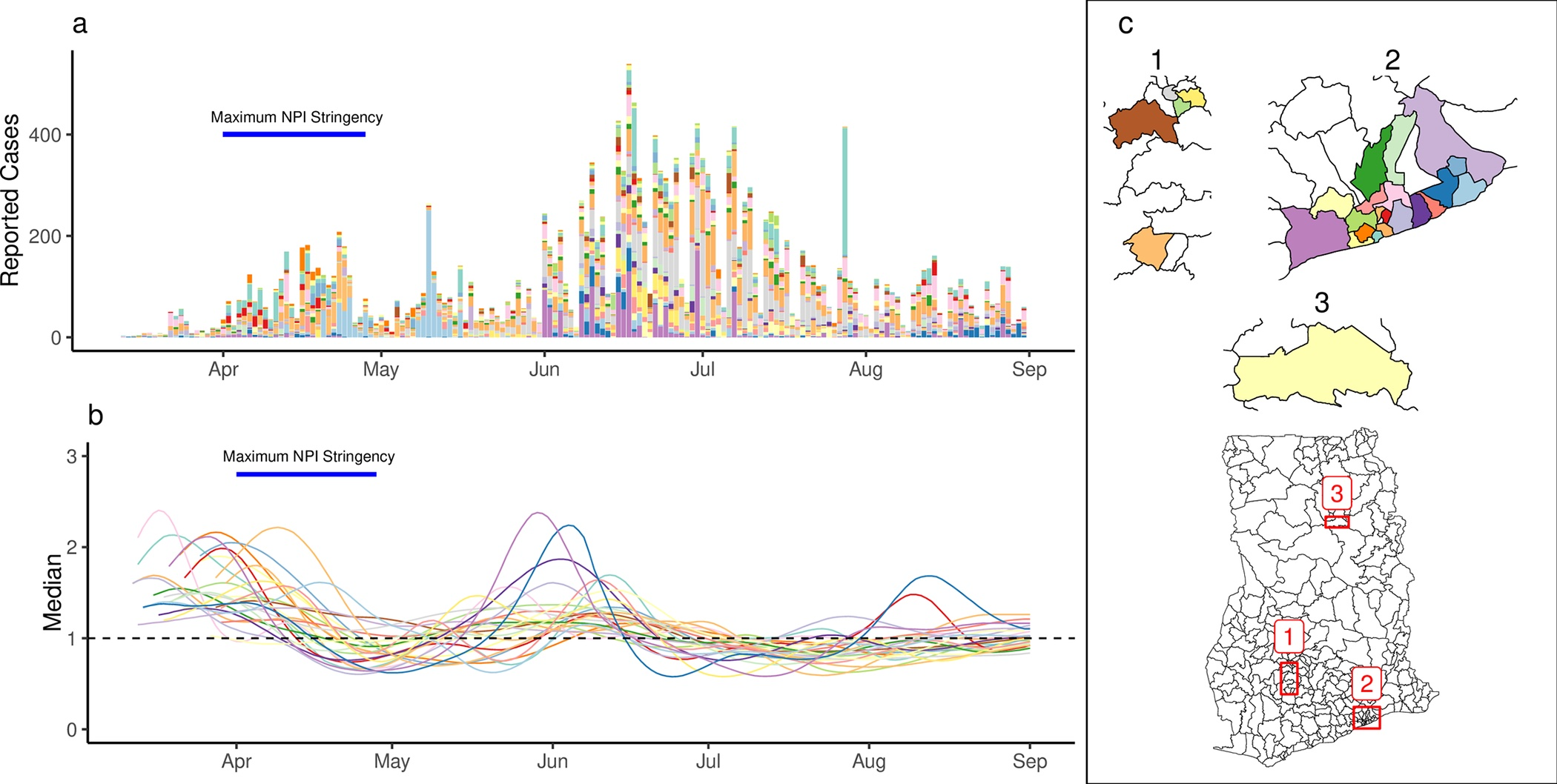Authors: Hamish Gibbs, Yang Liu, Sam Abbott, Isaac Baffoe-Nyarko, Dennis O. Laryea, Ernest Akyereko, Patrick Kuma-Aboagye, Ivy Asantewaa Asante, Oriol Mitjà, LSHTM CMMID COVID-19 Working Group, William Ampofo, Franklin Asiedu-Bekoe, Michael Marks, Rosalind M. Eggo
Published: September, 2022 in PLOS Global Public Health

Abstract
Governments around the world have implemented non-pharmaceutical interventions to limit the transmission of COVID-19. Here we assess if increasing NPI stringency was associated with a reduction in COVID-19 cases in Ghana. While lockdowns and physical distancing have proven effective for reducing COVID-19 transmission, there is still limited understanding of how NPI measures are reflected in indicators of human mobility. Further, there is a lack of understanding about how findings from high-income settings correspond to low and middle-income contexts. In this study, we assess the relationship between indicators of human mobility, NPIs, and estimates of Rt, a real-time measure of the intensity of COVID-19 transmission. We construct a multilevel generalised linear mixed model, combining local disease surveillance data from subnational districts of Ghana with the timing of NPIs and indicators of human mobility from Google and Vodafone Ghana. We observe a relationship between reductions in human mobility and decreases in Rt during the early stages of the COVID-19 epidemic in Ghana. We find that the strength of this relationship varies through time, decreasing after the most stringent period of interventions in the early epidemic. Our findings demonstrate how the association of NPI and mobility indicators with COVID-19 transmission may vary through time. Further, we demonstrate the utility of combining local disease surveillance data with large scale human mobility data to augment existing surveillance capacity to monitor the impact of NPI policies.
Cite
@article{gibbs_association_2022,
title = {Association between mobility, non-pharmaceutical interventions, and {COVID}-19 transmission in Ghana: A modelling study using mobile phone data},
volume = {2},
issn = {2767-3375},
url = {https://journals.plos.org/globalpublichealth/article?id=10.1371/journal.pgph.0000502},
doi = {10.1371/journal.pgph.0000502},
shorttitle = {Association between mobility, non-pharmaceutical interventions, and {COVID}-19 transmission in Ghana},
abstract = {Governments around the world have implemented non-pharmaceutical interventions to limit the transmission of {COVID}-19. Here we assess if increasing {NPI} stringency was associated with a reduction in {COVID}-19 cases in Ghana. While lockdowns and physical distancing have proven effective for reducing {COVID}-19 transmission, there is still limited understanding of how {NPI} measures are reflected in indicators of human mobility. Further, there is a lack of understanding about how findings from high-income settings correspond to low and middle-income contexts. In this study, we assess the relationship between indicators of human mobility, {NPIs}, and estimates of Rt, a real-time measure of the intensity of {COVID}-19 transmission. We construct a multilevel generalised linear mixed model, combining local disease surveillance data from subnational districts of Ghana with the timing of {NPIs} and indicators of human mobility from Google and Vodafone Ghana. We observe a relationship between reductions in human mobility and decreases in Rt during the early stages of the {COVID}-19 epidemic in Ghana. We find that the strength of this relationship varies through time, decreasing after the most stringent period of interventions in the early epidemic. Our findings demonstrate how the association of {NPI} and mobility indicators with {COVID}-19 transmission may vary through time. Further, we demonstrate the utility of combining local disease surveillance data with large scale human mobility data to augment existing surveillance capacity to monitor the impact of {NPI} policies.},
pages = {e0000502},
number = {9},
journaltitle = {{PLOS} Global Public Health},
shortjournal = {{PLOS} Global Public Health},
author = {Gibbs, Hamish and Liu, Yang and Abbott, Sam and Baffoe-Nyarko, Isaac and Laryea, Dennis O. and Akyereko, Ernest and Kuma-Aboagye, Patrick and Asante, Ivy Asantewaa and Mitjà, Oriol and Group, {LSHTM} {CMMID} {COVID}-19 Working and Ampofo, William and Asiedu-Bekoe, Franklin and Marks, Michael and Eggo, Rosalind M.},
urldate = {2023-09-01},
date = {2022-09-13},
langid = {english},
note = {Publisher: Public Library of Science},
keywords = {Human mobility, Urban areas, Cell phones, Ghana, {COVID} 19, Pandemics, Virus testing, Disease surveillance},
file = {Full Text PDF:/Users/hamishgibbs/Zotero/storage/VDESAVLT/Gibbs et al. - 2022 - Association between mobility, non-pharmaceutical i.pdf:application/pdf},
}